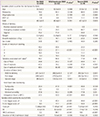1. Singh BS, Clark RH, Powers RJ, Spitzer AR. Meconium aspiration syndrome remains a significant problem in the NICU: outcomes and treatment patterns in term neonates admitted for intensive care during a ten-year period. J Perinatol. 2009; 29:497–503.
2. Beligere N, Rao R. Neurodevelopmental outcome of infants with meconium aspiration syndrome: report of a study and literature review. J Perinatol. 2008; 28:Suppl 3. S93–S101.
3. Espinheira MC, Grilo M, Rocha G, Guedes B, Guimaraes H. Meconium aspiration syndrome: the experience of a tertiary center. Rev Port Pneumol. 2011; 17:71–76.
4. Anwar Z, Butt TK, Kazi MY. Mortality in meconium aspiration syndrome in hospitalized babies. J Coll Physicians Surg Pak. 2011; 21:695–699.
5. Velaphi S, Van Kwawegen A. Meconium aspiration syndrome requiring assisted ventilation: perspective in a setting with limited resources. J Perinatol. 2008; 28:Suppl 3. S36–S42.
6. Oh SY, Roh CR. Contemporary medical understanding of the 'no-fault accident' during birth: amniotic fluid embolism, pulmonary embolism, meconium aspiration syndrome, and cerebral palsy. J Korean Med Assoc. 2013; 56:784–804.
7. Fischer C, Rybakowski C, Ferdynus C, Sagot P, Gouyon JB. A population-based study of meconium aspiration syndrome in neonates born between 37 and 43 weeks of gestation. Int J Pediatr. 2012; 2012:321545.
8. Ahanya SN, Lakshmanan J, Morgan BL, Ross MG. Meconium passage in utero: mechanisms, consequences, and management. Obstet Gynecol Surv. 2005; 60:45–56.
9. Hofmeyr GJ, Xu H. Amnioinfusion for meconiumstained liquor in labour. Cochrane Database Syst Rev. 2010; CD000014.
10. Lauzon L, Hodnett E. Labour assessment programs to delay admission to labour wards. Cochrane Database Syst Rev. 2001; CD000936.
11. Zhang X, Kramer MS. Variations in mortality and morbidity by gestational age among infants born at term. J Pediatr. 2009; 154:358–362. 362.e1
12. Fanaroff AA. Meconium aspiration syndrome: historical aspects. J Perinatol. 2008; 28:Suppl 3. S3–S7.
13. Ross MG. Meconium aspiration syndrome: more than intrapartum meconium. N Engl J Med. 2005; 353:946–948.
14. Whitfield JM, Charsha DS, Chiruvolu A. Prevention of meconium aspiration syndrome: an update and the Baylor experience. Proc (Bayl Univ Med Cent). 2009; 22:128–131.
15. Osava RH, Silva FM, Vasconcellos de Oliveira SM, Tuesta EF, Amaral MC. Meconium-stained amniotic fluid and maternal and neonatal factors associated. Rev Saude Publica. 2012; 46:1023–1029.
16. Paz Y, Solt I, Zimmer EZ. Variables associated with meconium aspiration syndrome in labors with thick meconium. Eur J Obstet Gynecol Reprod Biol. 2001; 94:27–30.
17. Khazardoost S, Hantoushzadeh S, Khooshideh M, Borna S. Risk factors for meconium aspiration in meconium stained amniotic fluid. J Obstet Gynaecol. 2007; 27:577–579.
18. Xu H, Calvet M, Wei S, Luo ZC, Fraser WD. Amnioinfusion Study Group. Risk factors for early and late onset of respiratory symptoms in babies born through meconium. Am J Perinatol. 2010; 27:271–278.
19. Balchin I, Whittaker JC, Lamont RF, Steer PJ. Maternal and fetal characteristics associated with meconium-stained amniotic fluid. Obstet Gynecol. 2011; 117:828–835.
20. Karatekin G, Kesim MD, Nuhoglu A. Risk factors for meconium aspiration syndrome. Int J Gynaecol Obstet. 1999; 65:295–297.
21. Dargaville PA, Copnell B. Australian and New Zealand Neonatal Network. The epidemiology of meconium aspiration syndrome: incidence, risk factors, therapies, and outcome. Pediatrics. 2006; 117:1712–1721.
22. Xu H, Wei S, Fraser WD. Obstetric approaches to the prevention of meconium aspiration syndrome. J Perinatol. 2008; 28:Suppl 3. S14–S18.
23. Vivian-Taylor J, Sheng J, Hadfield RM, Morris JM, Bowen JR, Roberts CL. Trends in obstetric practices and meconium aspiration syndrome: a population-based study. BJOG. 2011; 118:1601–1607.
24. Bhutani VK. Developing a systems approach to prevent meconium aspiration syndrome: lessons learned from multinational studies. J Perinatol. 2008; 28:Suppl 3. S30–S35.
25. Hernandez C, Little BB, Dax JS, Gilstrap LC 3rd, Rosenfeld CR. Prediction of the severity of meconium aspiration syndrome. Am J Obstet Gynecol. 1993; 169:61–70.
26. Wiswell TE. Handling the meconium-stained infant. Semin Neonatol. 2001; 6:225–231.
27. Usta IM, Mercer BM, Sibai BM. Risk factors for meconium aspiration syndrome. Obstet Gynecol. 1995; 86:230–234.
28. Ghidini A, Spong CY. Severe meconium aspiration syndrome is not caused by aspiration of meconium. Am J Obstet Gynecol. 2001; 185:931–938.
29. Sunoo C, Kosasa TS, Hale RW. Meconium aspiration syndrome without evidence of fetal distress in early labor before elective cesarean delivery. Obstet Gynecol. 1989; 73:707–709.
30. Spong CY, Ogundipe OA, Ross MG. Prophylactic amnioinfusion for meconium-stained amniotic fluid. Am J Obstet Gynecol. 1994; 171:931–935.
31. Turbeville DF, McCaffree MA, Block MF, Krous HF. In utero distal pulmonary meconium aspiration. South Med J. 1979; 72:535–536.
32. Brown BL, Gleicher N. Intrauterine meconium aspiration. Obstet Gynecol. 1981; 57:26–29.
33. Cleary GM, Wiswell TE. Meconium-stained amniotic fluid and the meconium aspiration syndrome: an update. Pediatr Clin North Am. 1998; 45:511–529.
34. Wiswell TE, Bent RC. Meconium staining and the meconium aspiration syndrome: unresolved issues. Pediatr Clin North Am. 1993; 40:955–981.
35. Yoder BA, Kirsch EA, Barth WH, Gordon MC. Changing obstetric practices associated with decreasing incidence of meconium aspiration syndrome. Obstet Gynecol. 2002; 99:731–739.
36. Yeomans ER, Gilstrap LC 3rd, Leveno KJ, Burris JS. Meconium in the amniotic fluid and fetal acid-base status. Obstet Gynecol. 1989; 73:175–178.
37. Carbonne B, Cudeville C, Sivan H, Cabrol D, Papiernik E. Fetal oxygen saturation measured by pulse oximetry during labour with clear or meconium-stained amniotic fluid. Eur J Obstet Gynecol Reprod Biol. 1997; 72:Suppl. S51–S55.
38. Blackwell SC, Moldenhauer J, Hassan SS, Redman ME, Refuerzo JS, Berry SM, et al. Meconium aspiration syndrome in term neonates with normal acid-base status at delivery: is it different? Am J Obstet Gynecol. 2001; 184:1422–1425.
39. Thureen PJ, Hall DM, Hoffenberg A, Tyson RW. Fatal meconium aspiration in spite of appropriate perinatal airway management: pulmonary and placental evidence of prenatal disease. Am J Obstet Gynecol. 1997; 176:967–975.
40. Burgess AM, Hutchins GM. Inflammation of the lungs, umbilical cord and placenta associated with meconium passage in utero: review of 123 autopsied cases. Pathol Res Pract. 1996; 192:1121–1128.






 PDF
PDF ePub
ePub Citation
Citation Print
Print



 XML Download
XML Download